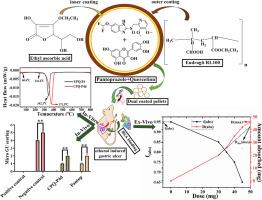抗坏血酸乙酯保护槲皮素-泮托拉唑微丸的抗溃疡和抗炎作用及其与牛血清白蛋白的多酚结合体外,体内和计算机分析
IF 5.2
2区 化学
Q2 CHEMISTRY, PHYSICAL
引用次数: 0
摘要
本研究的目的是通过槲皮素(Quer)与牛血清白蛋白(BSA)的拮抗结合来提高质子泵抑制剂(PPI)的效价。以EAA和Eudragit RL-100 (ERL-100)分别为内包被和外包被制备泮托拉唑(Pantop)和Quer双包被微丸(CPQ-P4a-d)。观察了Quer和EAA的碱性敏感性、渗透特性和DPPH清除活性。观察到从未包覆颗粒(UPQP4)表面的负电荷到CPQ-P4a-d表面的正电荷的变化,这可能是由于ERL-100中季铵的存在,最终有利于粘接行为。采用新开发的高效液相色谱(HPLC)方法和计算研究,观察了Pantop和Quer在BSA位点I和位点III上的含量均匀性和以氢键形式的结合相互作用。结合图Stern-Volmer, Direct, Scatchard, Klotz和Hitchcock提供了配体- bsa相互作用的性质,化学计量和结合强度的补充信息。最大可吸收剂量(MAD)为42±0.01%,足部水肿抑制率为83.1±1.12%,溃疡指数率为82.12±1.42%,溃疡评分分别为0和1±0.04%,经组织病理学评分模型计算CPQP4d具有抗溃疡作用。降低溃疡严重程度和恢复胃pH值,证明CPQP4d可作为常规治疗胃溃疡(GU)和萎缩性胃炎(AG)的替代方法。本文章由计算机程序翻译,如有差异,请以英文原文为准。

Anti-ulcerogenic and anti-inflammatory potential of ethyl ascorbic acid protected quercetin-pantoprazole pellets and its polyphenolic binding with bovine serum albumin; in-vitro, in vivo, and in-silico analysis
The objective of the recent study was to improve the potency of proton pump inhibitors (PPI) by antagonistic binding of quercetin (Quer) with bovine serum albumin (BSA) previously protected by newly synthesized ethyl ascorbic acid (EAA). Dually coated pellets (CPQ-P4a-d) of Pantoprazole (Pantop) and Quer were prepared by using EAA and Eudragit RL-100 (ERL-100) as inner and outer coats, respectively. Alkaline sensitivity, permeation properties, and DPPH scavenging activity of Quer and EAA were observed. Changes from the negative charge on the surface of uncoated pellets (UPQ![]() P4) to the positive charge in CPQ-P4a-d were observed and may be due to the presence of quaternary ammonium in ERL-100, which ultimately favored mucoadhesive behavior. Content uniformity and confirmation of the binding interaction in the form of hydrogen bonding of Pantop and Quer at site I and site III of BSA were observed by the newly developed High-performance Liquid Chromatography (HPLC) method and computational studies. Binding plots Stern-Volmer, Direct, Scatchard, Klotz, and Hitchcock provide complimentary information about the ligand-BSA interaction's nature, stoichiometry, and binding strength. Maximum absorbable dose (MAD) was 42 ± 0.01 %, paw edema inhibition was 83.1 ± 1.12 %, ulcer index rate was 82.12 ± 1.42 % and ulcer score turned to 0 and 1 ± 0.04 % with CPQ
P4) to the positive charge in CPQ-P4a-d were observed and may be due to the presence of quaternary ammonium in ERL-100, which ultimately favored mucoadhesive behavior. Content uniformity and confirmation of the binding interaction in the form of hydrogen bonding of Pantop and Quer at site I and site III of BSA were observed by the newly developed High-performance Liquid Chromatography (HPLC) method and computational studies. Binding plots Stern-Volmer, Direct, Scatchard, Klotz, and Hitchcock provide complimentary information about the ligand-BSA interaction's nature, stoichiometry, and binding strength. Maximum absorbable dose (MAD) was 42 ± 0.01 %, paw edema inhibition was 83.1 ± 1.12 %, ulcer index rate was 82.12 ± 1.42 % and ulcer score turned to 0 and 1 ± 0.04 % with CPQ![]() P4d proved its anti-ulcerant effect which were calculated by the histopathological scoring model. Reduction in severity of ulcers and restoration of stomach pH, proved CPQ
P4d proved its anti-ulcerant effect which were calculated by the histopathological scoring model. Reduction in severity of ulcers and restoration of stomach pH, proved CPQ![]() P4d as an alternative of conventional treatment of gastric ulcers (GU) and atrophic gastritis (AG).
P4d as an alternative of conventional treatment of gastric ulcers (GU) and atrophic gastritis (AG).
求助全文
通过发布文献求助,成功后即可免费获取论文全文。
去求助
来源期刊

Journal of Molecular Liquids
化学-物理:原子、分子和化学物理
CiteScore
10.30
自引率
16.70%
发文量
2597
审稿时长
78 days
期刊介绍:
The journal includes papers in the following areas:
– Simple organic liquids and mixtures
– Ionic liquids
– Surfactant solutions (including micelles and vesicles) and liquid interfaces
– Colloidal solutions and nanoparticles
– Thermotropic and lyotropic liquid crystals
– Ferrofluids
– Water, aqueous solutions and other hydrogen-bonded liquids
– Lubricants, polymer solutions and melts
– Molten metals and salts
– Phase transitions and critical phenomena in liquids and confined fluids
– Self assembly in complex liquids.– Biomolecules in solution
The emphasis is on the molecular (or microscopic) understanding of particular liquids or liquid systems, especially concerning structure, dynamics and intermolecular forces. The experimental techniques used may include:
– Conventional spectroscopy (mid-IR and far-IR, Raman, NMR, etc.)
– Non-linear optics and time resolved spectroscopy (psec, fsec, asec, ISRS, etc.)
– Light scattering (Rayleigh, Brillouin, PCS, etc.)
– Dielectric relaxation
– X-ray and neutron scattering and diffraction.
Experimental studies, computer simulations (MD or MC) and analytical theory will be considered for publication; papers just reporting experimental results that do not contribute to the understanding of the fundamentals of molecular and ionic liquids will not be accepted. Only papers of a non-routine nature and advancing the field will be considered for publication.
 求助内容:
求助内容: 应助结果提醒方式:
应助结果提醒方式:


